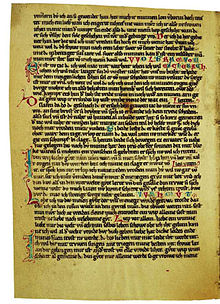Gothic minuscule

The Gothic minuscule is a minuscule font that was developed in scriptoria in the European Middle Ages in the Gothic art era . It's broken script .
history
The Gothic minuscule replaced the Carolingian minuscule in manuscripts . It was also used for inscriptions .
As a modern typeface at the time, it was also implemented as a typeface and used in incunabula with the start of letterpress printing from the middle of the 15th century . In its pure form it corresponds to the textura of letterpress printing.
features
Like all minuscule fonts, the Gothic minuscule is based on a four-line scheme in which the line is divided into three writing zones and some of the letters have ascenders and / or descenders. The middle length area is limited by the baseline on which the letters stand and the top line of the middle length area. It is characteristic of the Gothic minuscule that the shafts of the letters break at the base line and the top line of the middle length area. The arcs of the letters can break off at obtuse angles as well as bend at acute angles and are replaced by vertical and inclined components. The so-called arc connections are also characteristic: the arcs of the letters facing each other are connected to one another so that the vertical stroke is common to both.
literature
- Joachim Kirchner : Scriptura Gothica libraria: a saeculo XII usque ad finem Medii Aevi . Munich 1966 (Tafelwerk)
- Ernst Crous - Joachim Kirchner: The Gothic fonts . Leipzig 1928 (reprint Braunschweig 1970)
- Wilhelm Meyer : The letter connections of the so-called Gothic script . Berlin 1897 (= treatises of the Royal Society of Sciences in Göttingen , NS 1,6) ( full text ) at the MDZ
Web links
- Thomas Frenz: Bibliography on Gothic script (PDF; 125 KB)
- University of Passau: Paleography - Gothic script
- Gothic writings , University of Bamberg
